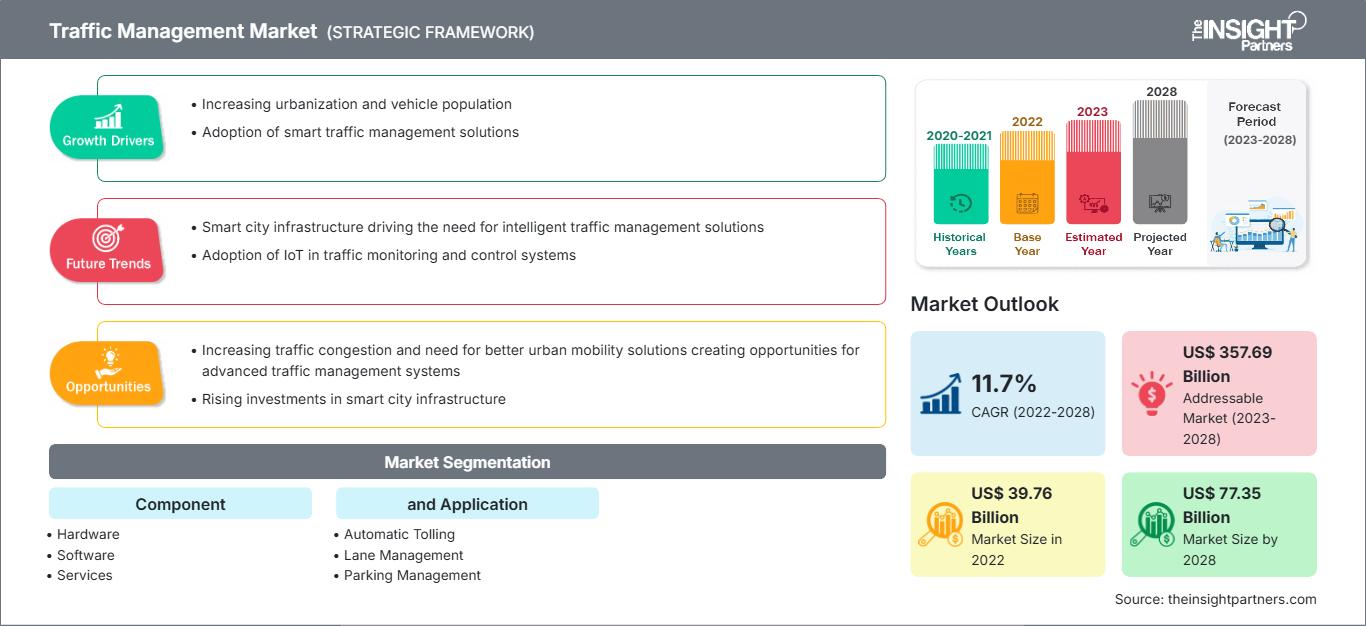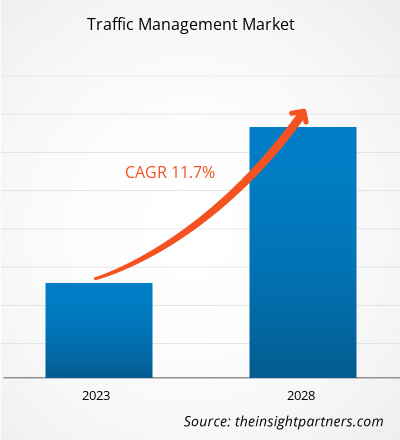Der Markt für Verkehrsmanagement soll Prognosen zufolge von 39.756,74 Millionen US-Dollar im Jahr 2022 auf 77.346,44 Millionen US-Dollar im Jahr 2028 anwachsen; von 2022 bis 2028 wird ein durchschnittliches jährliches Wachstum von 11,7 % erwartet.
In den meisten Ländern hat im Laufe der Jahre eine drastische Urbanisierung stattgefunden, die zu komplexen Straßennetzen und hoher Verkehrsüberlastung geführt hat. Die steigende Stadtbevölkerung sowie die zunehmende Zahl privater Pkw-Besitzer führen zu einer steigenden Zahl von Fahrzeugen auf den Straßen. Die Bevölkerung im indischen Mumbai stieg von 18,5 Millionen im Jahr 2011 auf 20,4 Millionen im Jahr 2020, während sich die Zahl der privaten Pkw in diesem Zeitraum fast verdoppelte. Aufgrund dieser und deren Behebung wird ein Wachstum des Marktes für Verkehrsmanagement erwartet. Darüber hinaus verzeichnen Mitfahrdienste von Taxi-Aggregatoren wie Uber, Grab, Ola und Lyft einen rasanten Anstieg. Solche Dienste haben öffentliche Verkehrsmittel ersetzt, was zu einem Anstieg der Fahrzeugzahlen auf den Straßen geführt hat. Diese Faktoren zwingen Regierungsbehörden, sich an Akteure des Verkehrsmanagementmarktes zu wenden, um wirksame Lösungen zu finden. Verkehrsstaus können mit einem robusten Verkehrsmanagementsystem, das Software, Sensoren, Kameras und Anzeigetafeln umfasst, wirksam reduziert werden. Diese Systeme können auf einer bestehenden Straße installiert werden, ohne dass infrastrukturelle Änderungen erforderlich sind. Ebenso kann ein Fahrspurmanagementsystem den Verkehrsfluss effektiv regeln, indem es je nach Verkehrsaufkommen zu jedem Zeitpunkt Fahrspuren öffnet oder schließt. In Anbetracht der Vorteile von Verkehrsmanagementsystemen wird erwartet, dass die schnelle Urbanisierungsrate den Markt für Verkehrsmanagement stark anwachsen lassen wird.
Auswirkungen der COVID-19-Pandemie auf das Wachstum des Verkehrsmanagementmarktes
Der COVID-19-Ausbruch störte Branchen wie die Automobilindustrie, die Fertigung, die Energie- und Stromindustrie, die Luft- und Raumfahrtindustrie und Verteidigung, Bauwesen im Jahr 2020. Der kontinuierliche Anstieg der COVID-Patientenzahlen zwang die Regierungsbehörden in den USA und anderen Ländern, in den ersten drei Quartalen 2020 strenge Lockdowns zu verhängen. Dies führte in allen Ländern zu einem deutlichen Rückgang des Transportwesens. Die Umsetzung von Eindämmungsmaßnahmen wie Handelsverboten, Reisebeschränkungen und Personalbeschränkungen beeinträchtigten die Herstellungs-, Liefer- und Vertriebsaktivitäten verschiedener Unternehmen, darunter auch der Anbieter von Hardware, Software und Dienstleistungen für das Verkehrsmanagement. Der Fertigungssektor verzeichnete schwere Verluste aufgrund vorübergehender Fabrikschließungen und geringer Produktionsmengen, was auch die Herstellung von Hardwaresystemen für das Verkehrsmanagement behinderte. In den USA konzentrierten sich die Bundes- und Landesregierungen stärker auf die Bekämpfung der Pandemie; daher wurde die Installation von Hard- und Software für das Verkehrsmanagement vorübergehend ausgesetzt. Die europäische Verkehrsmanagementbranche wurde durch einen Rückgang der Ausgaben für Infrastrukturprojekte um ca. 20 % schwer getroffen, was zu Verzögerungen und der Einstellung mehrerer Smart-City- und Smart-Roadways-Projekte führte. Höhere Halbleiterpreise und unterbrochene Lieferketten verschärften die Situation zusätzlich. Allerdings begann der Markt für Verkehrsmanagement im vierten Quartal 2020 ein positives Wachstum zu verzeichnen.
Passen Sie diesen Bericht Ihren Anforderungen an
Sie erhalten kostenlos Anpassungen an jedem Bericht, einschließlich Teilen dieses Berichts oder einer Analyse auf Länderebene, eines Excel-Datenpakets sowie tolle Angebote und Rabatte für Start-ups und Universitäten.
Markt für Verkehrsmanagement: Strategische Einblicke

- Holen Sie sich die wichtigsten Markttrends aus diesem Bericht.Dieses KOSTENLOSE Beispiel umfasst Datenanalysen, die von Markttrends bis hin zu Schätzungen und Prognosen reichen.
Sie erhalten kostenlos Anpassungen an jedem Bericht, einschließlich Teilen dieses Berichts oder einer Analyse auf Länderebene, eines Excel-Datenpakets sowie tolle Angebote und Rabatte für Start-ups und Universitäten.
Markt für Verkehrsmanagement: Strategische Einblicke

- Holen Sie sich die wichtigsten Markttrends aus diesem Bericht.Dieses KOSTENLOSE Beispiel umfasst Datenanalysen, die von Markttrends bis hin zu Schätzungen und Prognosen reichen.
Markteinblicke – Markt für Verkehrsmanagement
Die Welt erlebt einen Boom bei vernetzten Geräten, und mehrere Länder investieren in die Entwicklung von Smart Cities. Smart Cities sind technologisch fortschrittliche Stadtgebiete, die eine Vielzahl von Sensoren und elektronischen Methoden zur Datenerfassung und -nutzung zur Verbesserung der lokalen Situation einsetzen. Smart Cities basieren auf langfristigen Plänen zur Verkehrssteuerung durch Optimierung von Transport und Logistik sowie zur Reduzierung von Staus. Daher investieren Länder neben Smart Cities auch in die Entwicklung intelligenter Straßen, um einen sichereren Autoverkehr zu gewährleisten. Auf intelligenten Straßen erfassen verschiedene Arten von Sensoren und Hardware multivariate Daten, die zur Verkehrsüberwachung verwendet werden. Die Daten können auch mit den Fahrzeugen geteilt werden, die auf der Straße unterwegs sind, sodass Fahrer und Pendler fundierte Entscheidungen treffen können. Daher ist zu erwarten, dass die zunehmende Nutzung von Smart Cities und intelligenten Straßen den Markt für Verkehrsmanagement vergrößern wird.
Komponentenbasierte Einblicke
Der Markt für Verkehrsmanagement ist nach Komponenten, Anwendungen und geografischer Lage segmentiert. Der Markt ist nach Komponenten in Hardware, Software und Dienstleistungen unterteilt. Der Markt für Hardware ist weiter in Kameras, Anzeigetafeln und Sensoren segmentiert; der Markt für Software ist in Cloud und On-Premise aufgespalten. Verschiedene Regierungsbehörden haben in die Modernisierung ihrer Verkehrsmanagement-Hardware investiert. Die zunehmende Urbanisierung und der steigende Autobesitz belasten die städtischen Straßen. Daher verlassen sich die Behörden auf moderne Kameras, um den Verkehrsfluss besser aufrechtzuerhalten und die Sicherheit zu gewährleisten. Kameras zur automatischen Nummernschilderkennung (ANPR) werden zunehmend eingesetzt, um Verkehrssünder zu identifizieren oder Fahrzeuge bei Unfalluntersuchungen zu orten. Sie werden oft mit Lasersensoren kombiniert, um die Geschwindigkeit eines Fahrzeugs zu bestimmen.
Nach Anwendung ist der Markt für Verkehrsmanagement in automatische Mauterhebung, Fahrspurmanagement, Parkraummanagement, Überwachung, Ampelsteuerung und andere segmentiert. Geografisch ist der Markt hauptsächlich in Nordamerika, Europa, Asien-Pazifik (APAC), Naher Osten und Afrika (MEA) und Südamerika (SAM) segmentiert. IBM Corporation; Cisco Systems, Inc.; Siemens AG; Hangzhou Hikvision Digital Technology Co., Ltd.; und Dahua Technology Co., Ltd. gehören zu den wichtigsten Akteuren auf dem Markt für Verkehrsmanagement.
VerkehrsmanagementRegionale Einblicke in den Verkehrsmanagementmarkt
Die Analysten von The Insight Partners haben die regionalen Trends und Faktoren, die den Verkehrsmanagementmarkt im Prognosezeitraum beeinflussen, ausführlich erläutert. In diesem Abschnitt werden auch die Marktsegmente und die geografische Lage in Nordamerika, Europa, dem asiatisch-pazifischen Raum, dem Nahen Osten und Afrika sowie Süd- und Mittelamerika erörtert.
Umfang des Marktberichts zum Verkehrsmanagement
| Berichtsattribut | Einzelheiten |
|---|---|
| Marktgröße in 2022 | US$ 39.76 Billion |
| Marktgröße nach 2028 | US$ 77.35 Billion |
| Globale CAGR (2022 - 2028) | 11.7% |
| Historische Daten | 2020-2021 |
| Prognosezeitraum | 2023-2028 |
| Abgedeckte Segmente |
By Komponente
|
| Abgedeckte Regionen und Länder | Nordamerika
|
| Marktführer und wichtige Unternehmensprofile |
|
Dichte der Marktteilnehmer im Verkehrsmanagement: Verständnis ihrer Auswirkungen auf die Geschäftsdynamik
Der Markt für Verkehrsmanagement wächst rasant, angetrieben von der steigenden Nachfrage der Endnutzer aufgrund von Faktoren wie sich verändernden Verbraucherpräferenzen, technologischem Fortschritt und einem stärkeren Bewusstsein für die Produktvorteile. Mit steigender Nachfrage erweitern Unternehmen ihr Angebot, entwickeln Innovationen, um den Bedürfnissen der Verbraucher gerecht zu werden, und nutzen neue Trends, was das Marktwachstum weiter ankurbelt.

- Holen Sie sich die Markt für Verkehrsmanagement Übersicht der wichtigsten Akteure
Die Akteure auf dem Markt für Verkehrsmanagement konzentrieren sich hauptsächlich auf die Entwicklung fortschrittlicher und effizienter Produkte.
- Im Jahr 2021 kündigte Dahua Technology die Entwicklung einer umfassenden intelligenten Verkehrsmanagementlösung an, die durch die Kombination von Videoüberwachung mit KI, ANPR, Bildfusion, AR und anderen Spitzentechnologien entwickelt wurde, um den vielfältigen Anforderungen moderner Verkehrsüberwachungsbehörden gerecht zu werden.
- Im Jahr 2021 stellte Hikvision, ein auf Kameras spezialisierter IoT-Lösungsanbieter, die All-Rounder ITS-Kamera vor, sein neuestes Verkehrsprodukt zur Verbesserung der Verkehrssicherheit und des Verkehrsflusses. Die Kamera vereint eine Vielzahl von Talenten und Fähigkeiten, darunter Geschwindigkeitserkennung, Erkennung von Verkehrsverstößen, automatische Kennzeichenerkennung und Fahrzeugattributanalyse in einem Paket.
- Historische Analyse (2 Jahre), Basisjahr, Prognose (7 Jahre) mit CAGR
- PEST- und SWOT-Analyse
- Marktgröße Wert/Volumen – Global, Regional, Land
- Branchen- und Wettbewerbslandschaft
- Excel-Datensatz
Aktuelle Berichte
Verwandte Berichte
Erfahrungsberichte
Grund zum Kauf
- Fundierte Entscheidungsfindung
- Marktdynamik verstehen
- Wettbewerbsanalyse
- Kundeneinblicke
- Marktprognosen
- Risikominimierung
- Strategische Planung
- Investitionsbegründung
- Identifizierung neuer Märkte
- Verbesserung von Marketingstrategien
- Steigerung der Betriebseffizienz
- Anpassung an regulatorische Trends




















 Kostenlose Probe anfordern für - Markt für Verkehrsmanagement
Kostenlose Probe anfordern für - Markt für Verkehrsmanagement